The Impact of Digital Technologies on Business Activities of TUI Group
VerifiedAdded on 2024/06/27
|33
|6375
|435
Report
AI Summary
This research report investigates the impact of digital technologies on business activities, specifically within the TUI Group. It outlines the research aim, objectives, and questions, focusing on the positive and negative impacts of digitalization, its influence on consumer purchasing behavior, its effect on economic conditions, and its role in cost management for travel and tourism companies. The study employs a positivism philosophy and a deductive approach, utilizing both primary and secondary data collected through random and non-probability sampling techniques. Findings are presented through quantitative and qualitative analyses, using tables and graphs to illustrate the impact of digital technologies on business activities. The report concludes with recommendations for future research, highlighting areas for improvement and further exploration in the evolving landscape of digital technology and business.
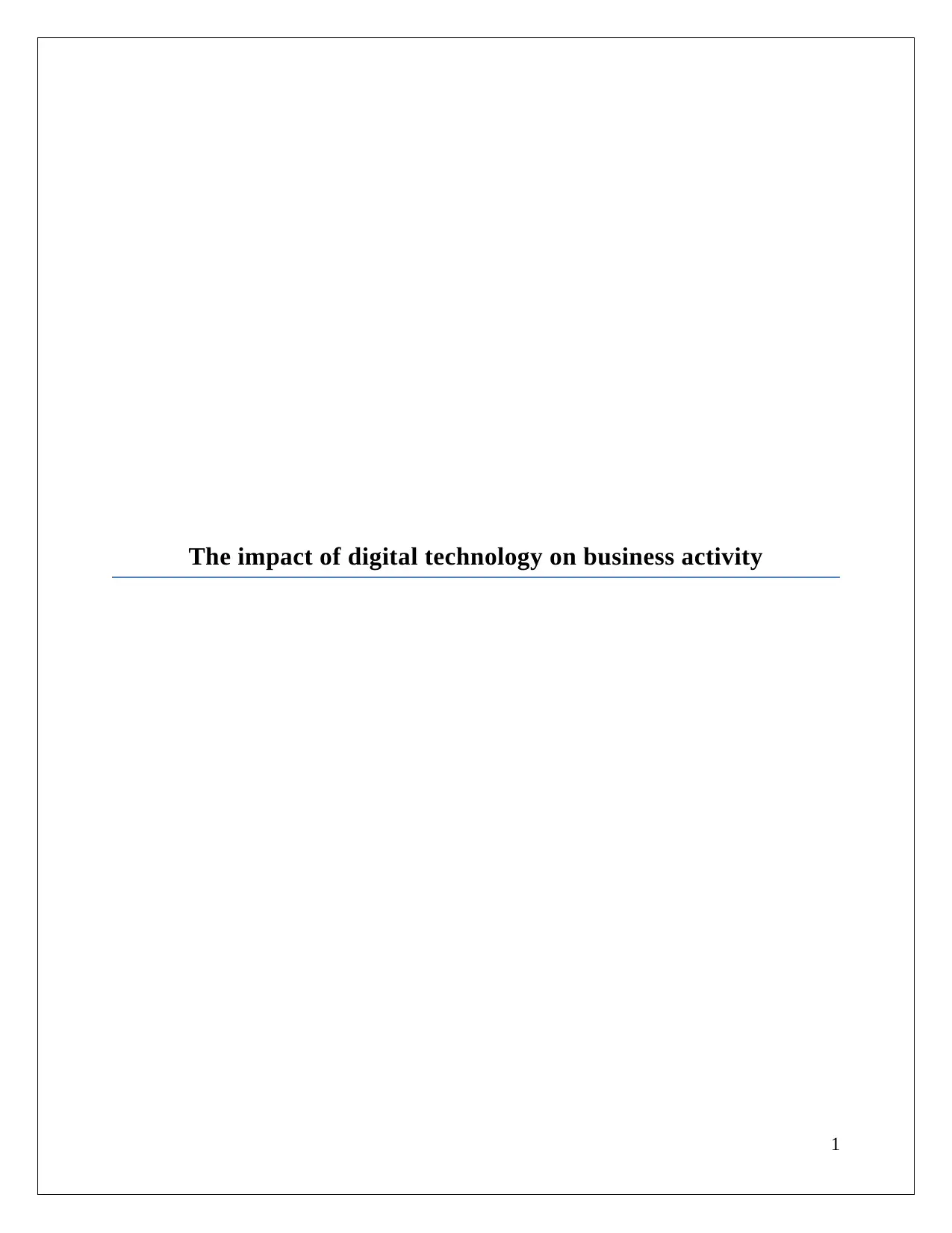
The impact of digital technology on business activity
1
1
Paraphrase This Document
Need a fresh take? Get an instant paraphrase of this document with our AI Paraphraser

Table of Contents
Chapter 1: Introduction....................................................................................................................5
1.0 Introduction............................................................................................................................5
1.1 Background of the research...................................................................................................5
1.2 Research Aim.........................................................................................................................5
1.3 Research Objectives...............................................................................................................5
1.4 Research Questions................................................................................................................6
1.5 Rationale of the Research......................................................................................................6
1.6 Terms and Limits of the research..........................................................................................6
1.7 Structure of the Research.......................................................................................................7
1.8 Summary................................................................................................................................7
Chapter 2: Literature Review...........................................................................................................8
2.0 Introduction............................................................................................................................8
2.1 Conceptual framework...........................................................................................................8
2.2 Latest digital technologies trends in the travel and tourism industry....................................9
2.3 Impact of digital technologies in the business operations of tour operators........................10
2.4 Digital implementation and business decision-making.......................................................11
2.5 Digital implementation and customer engagement.............................................................11
2.7 Conclusion...........................................................................................................................12
Chapter 3: Methodology................................................................................................................13
3.1 Research Philosophy............................................................................................................13
3.2 Research Approach..............................................................................................................13
3.5 Data Analysis.......................................................................................................................14
3.6 Sampling Techniques...........................................................................................................14
3.7 Ethical Considerations.........................................................................................................14
2
Chapter 1: Introduction....................................................................................................................5
1.0 Introduction............................................................................................................................5
1.1 Background of the research...................................................................................................5
1.2 Research Aim.........................................................................................................................5
1.3 Research Objectives...............................................................................................................5
1.4 Research Questions................................................................................................................6
1.5 Rationale of the Research......................................................................................................6
1.6 Terms and Limits of the research..........................................................................................6
1.7 Structure of the Research.......................................................................................................7
1.8 Summary................................................................................................................................7
Chapter 2: Literature Review...........................................................................................................8
2.0 Introduction............................................................................................................................8
2.1 Conceptual framework...........................................................................................................8
2.2 Latest digital technologies trends in the travel and tourism industry....................................9
2.3 Impact of digital technologies in the business operations of tour operators........................10
2.4 Digital implementation and business decision-making.......................................................11
2.5 Digital implementation and customer engagement.............................................................11
2.7 Conclusion...........................................................................................................................12
Chapter 3: Methodology................................................................................................................13
3.1 Research Philosophy............................................................................................................13
3.2 Research Approach..............................................................................................................13
3.5 Data Analysis.......................................................................................................................14
3.6 Sampling Techniques...........................................................................................................14
3.7 Ethical Considerations.........................................................................................................14
2
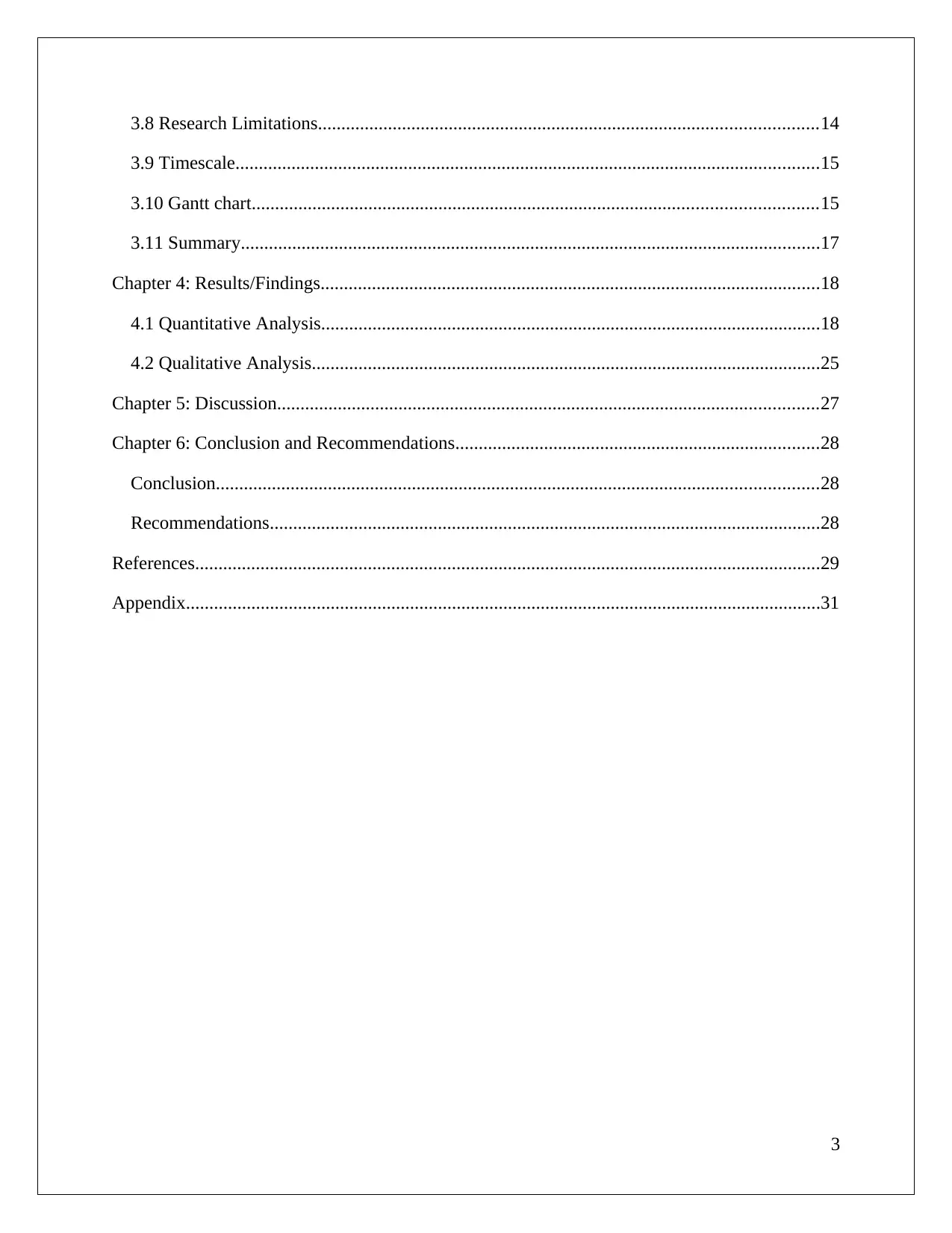
3.8 Research Limitations...........................................................................................................14
3.9 Timescale.............................................................................................................................15
3.10 Gantt chart.........................................................................................................................15
3.11 Summary............................................................................................................................17
Chapter 4: Results/Findings...........................................................................................................18
4.1 Quantitative Analysis...........................................................................................................18
4.2 Qualitative Analysis.............................................................................................................25
Chapter 5: Discussion....................................................................................................................27
Chapter 6: Conclusion and Recommendations..............................................................................28
Conclusion.................................................................................................................................28
Recommendations......................................................................................................................28
References......................................................................................................................................29
Appendix........................................................................................................................................31
3
3.9 Timescale.............................................................................................................................15
3.10 Gantt chart.........................................................................................................................15
3.11 Summary............................................................................................................................17
Chapter 4: Results/Findings...........................................................................................................18
4.1 Quantitative Analysis...........................................................................................................18
4.2 Qualitative Analysis.............................................................................................................25
Chapter 5: Discussion....................................................................................................................27
Chapter 6: Conclusion and Recommendations..............................................................................28
Conclusion.................................................................................................................................28
Recommendations......................................................................................................................28
References......................................................................................................................................29
Appendix........................................................................................................................................31
3
⊘ This is a preview!⊘
Do you want full access?
Subscribe today to unlock all pages.

Trusted by 1+ million students worldwide

Abstract
The research paper focused on the impact of digital technologies on the business activities of an
organization. This research paper clearly defines the aims, objectives, and questions of the
research. Further, the research paper also depicted the significance of the study concerning the
issues of digital technologies. The research was conducted using Positivism Philosophy,
Deductive Approach, Primary and Secondary Data collection, and Random Sampling
Techniques and non-probability sampling technique. Further, the findings were presented in the
form of tables and graphs. The researcher conducted quantitative and qualitative data analysis.
At last, the findings concerned with the impact of digital technologies on business activities and
future recommendations were provided for the betterment of future research works.
4
The research paper focused on the impact of digital technologies on the business activities of an
organization. This research paper clearly defines the aims, objectives, and questions of the
research. Further, the research paper also depicted the significance of the study concerning the
issues of digital technologies. The research was conducted using Positivism Philosophy,
Deductive Approach, Primary and Secondary Data collection, and Random Sampling
Techniques and non-probability sampling technique. Further, the findings were presented in the
form of tables and graphs. The researcher conducted quantitative and qualitative data analysis.
At last, the findings concerned with the impact of digital technologies on business activities and
future recommendations were provided for the betterment of future research works.
4
Paraphrase This Document
Need a fresh take? Get an instant paraphrase of this document with our AI Paraphraser
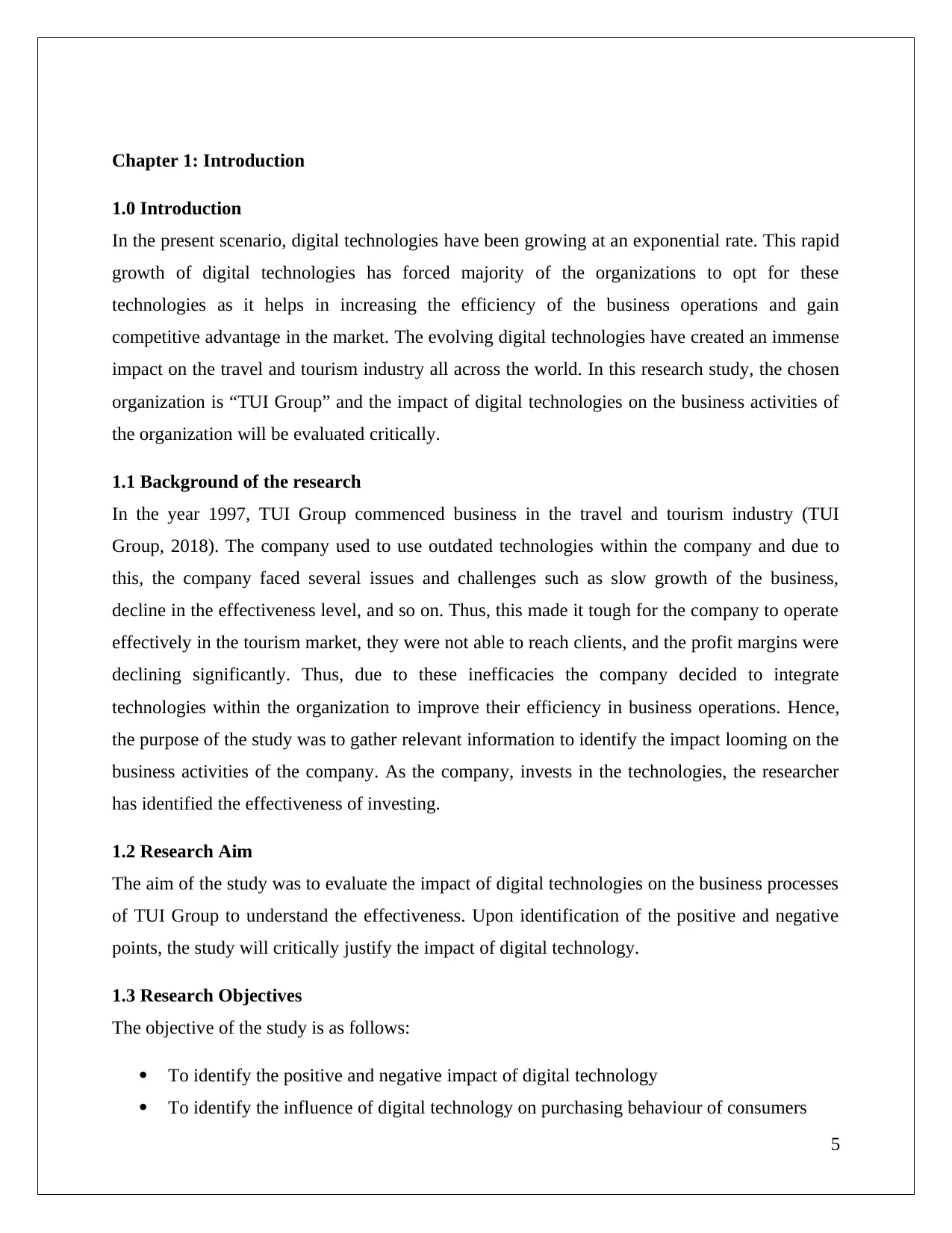
Chapter 1: Introduction
1.0 Introduction
In the present scenario, digital technologies have been growing at an exponential rate. This rapid
growth of digital technologies has forced majority of the organizations to opt for these
technologies as it helps in increasing the efficiency of the business operations and gain
competitive advantage in the market. The evolving digital technologies have created an immense
impact on the travel and tourism industry all across the world. In this research study, the chosen
organization is “TUI Group” and the impact of digital technologies on the business activities of
the organization will be evaluated critically.
1.1 Background of the research
In the year 1997, TUI Group commenced business in the travel and tourism industry (TUI
Group, 2018). The company used to use outdated technologies within the company and due to
this, the company faced several issues and challenges such as slow growth of the business,
decline in the effectiveness level, and so on. Thus, this made it tough for the company to operate
effectively in the tourism market, they were not able to reach clients, and the profit margins were
declining significantly. Thus, due to these inefficacies the company decided to integrate
technologies within the organization to improve their efficiency in business operations. Hence,
the purpose of the study was to gather relevant information to identify the impact looming on the
business activities of the company. As the company, invests in the technologies, the researcher
has identified the effectiveness of investing.
1.2 Research Aim
The aim of the study was to evaluate the impact of digital technologies on the business processes
of TUI Group to understand the effectiveness. Upon identification of the positive and negative
points, the study will critically justify the impact of digital technology.
1.3 Research Objectives
The objective of the study is as follows:
To identify the positive and negative impact of digital technology
To identify the influence of digital technology on purchasing behaviour of consumers
5
1.0 Introduction
In the present scenario, digital technologies have been growing at an exponential rate. This rapid
growth of digital technologies has forced majority of the organizations to opt for these
technologies as it helps in increasing the efficiency of the business operations and gain
competitive advantage in the market. The evolving digital technologies have created an immense
impact on the travel and tourism industry all across the world. In this research study, the chosen
organization is “TUI Group” and the impact of digital technologies on the business activities of
the organization will be evaluated critically.
1.1 Background of the research
In the year 1997, TUI Group commenced business in the travel and tourism industry (TUI
Group, 2018). The company used to use outdated technologies within the company and due to
this, the company faced several issues and challenges such as slow growth of the business,
decline in the effectiveness level, and so on. Thus, this made it tough for the company to operate
effectively in the tourism market, they were not able to reach clients, and the profit margins were
declining significantly. Thus, due to these inefficacies the company decided to integrate
technologies within the organization to improve their efficiency in business operations. Hence,
the purpose of the study was to gather relevant information to identify the impact looming on the
business activities of the company. As the company, invests in the technologies, the researcher
has identified the effectiveness of investing.
1.2 Research Aim
The aim of the study was to evaluate the impact of digital technologies on the business processes
of TUI Group to understand the effectiveness. Upon identification of the positive and negative
points, the study will critically justify the impact of digital technology.
1.3 Research Objectives
The objective of the study is as follows:
To identify the positive and negative impact of digital technology
To identify the influence of digital technology on purchasing behaviour of consumers
5
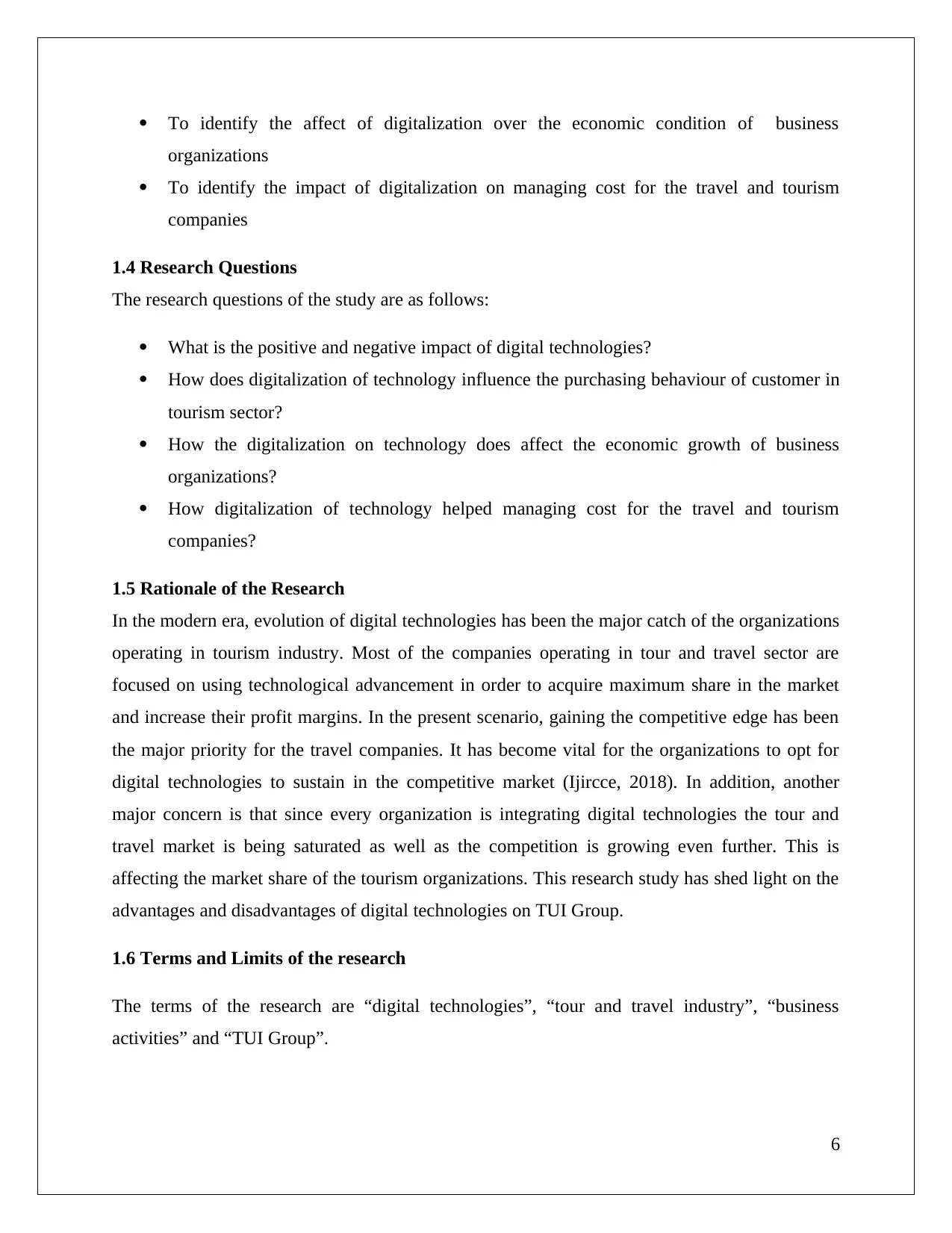
To identify the affect of digitalization over the economic condition of business
organizations
To identify the impact of digitalization on managing cost for the travel and tourism
companies
1.4 Research Questions
The research questions of the study are as follows:
What is the positive and negative impact of digital technologies?
How does digitalization of technology influence the purchasing behaviour of customer in
tourism sector?
How the digitalization on technology does affect the economic growth of business
organizations?
How digitalization of technology helped managing cost for the travel and tourism
companies?
1.5 Rationale of the Research
In the modern era, evolution of digital technologies has been the major catch of the organizations
operating in tourism industry. Most of the companies operating in tour and travel sector are
focused on using technological advancement in order to acquire maximum share in the market
and increase their profit margins. In the present scenario, gaining the competitive edge has been
the major priority for the travel companies. It has become vital for the organizations to opt for
digital technologies to sustain in the competitive market (Ijircce, 2018). In addition, another
major concern is that since every organization is integrating digital technologies the tour and
travel market is being saturated as well as the competition is growing even further. This is
affecting the market share of the tourism organizations. This research study has shed light on the
advantages and disadvantages of digital technologies on TUI Group.
1.6 Terms and Limits of the research
The terms of the research are “digital technologies”, “tour and travel industry”, “business
activities” and “TUI Group”.
6
organizations
To identify the impact of digitalization on managing cost for the travel and tourism
companies
1.4 Research Questions
The research questions of the study are as follows:
What is the positive and negative impact of digital technologies?
How does digitalization of technology influence the purchasing behaviour of customer in
tourism sector?
How the digitalization on technology does affect the economic growth of business
organizations?
How digitalization of technology helped managing cost for the travel and tourism
companies?
1.5 Rationale of the Research
In the modern era, evolution of digital technologies has been the major catch of the organizations
operating in tourism industry. Most of the companies operating in tour and travel sector are
focused on using technological advancement in order to acquire maximum share in the market
and increase their profit margins. In the present scenario, gaining the competitive edge has been
the major priority for the travel companies. It has become vital for the organizations to opt for
digital technologies to sustain in the competitive market (Ijircce, 2018). In addition, another
major concern is that since every organization is integrating digital technologies the tour and
travel market is being saturated as well as the competition is growing even further. This is
affecting the market share of the tourism organizations. This research study has shed light on the
advantages and disadvantages of digital technologies on TUI Group.
1.6 Terms and Limits of the research
The terms of the research are “digital technologies”, “tour and travel industry”, “business
activities” and “TUI Group”.
6
⊘ This is a preview!⊘
Do you want full access?
Subscribe today to unlock all pages.

Trusted by 1+ million students worldwide

The research is limited geographically since the research is conducted based on TUI Group that
is one of the tourism companies in Germany.
1.7 Structure of the Research
Figure 1: Structure of the Research
(Source: Created by learner)
1.8 Summary
In this chapter, a brief introduction about the digital technologies and its impact on the business
organizations had been presented. Further, research aim, objectives, and questions have been
provided based on which the research will be conducted. This chapter also discusses the rationale
of the research study that shows the issues of digital technologies.
7
IntroductionDiscussion
is one of the tourism companies in Germany.
1.7 Structure of the Research
Figure 1: Structure of the Research
(Source: Created by learner)
1.8 Summary
In this chapter, a brief introduction about the digital technologies and its impact on the business
organizations had been presented. Further, research aim, objectives, and questions have been
provided based on which the research will be conducted. This chapter also discusses the rationale
of the research study that shows the issues of digital technologies.
7
IntroductionDiscussion
Paraphrase This Document
Need a fresh take? Get an instant paraphrase of this document with our AI Paraphraser

Chapter 2: Literature Review
2.0 Introduction
In the literature review, impacts of digital technologies on the tour businesses of UK are
discussed by looking at the findings of other researchers. This literature will enable the
researcher in understanding the perception of other researchers on the implementations of digital
technologies in the business. In this literature review, the manner in which the digital technology
are influencing the businesses and its activities, which will create the vision of the positive and
the negative impacts of digitalization on the business.
The literature review would help the researcher in gaining knowledge regarding the use of
technologies in the business activities of the organizations. Moreover, it would highlight the
positive and negative impacts being created with the increased dependency on technology.
2.1 Conceptual framework
8
2.0 Introduction
In the literature review, impacts of digital technologies on the tour businesses of UK are
discussed by looking at the findings of other researchers. This literature will enable the
researcher in understanding the perception of other researchers on the implementations of digital
technologies in the business. In this literature review, the manner in which the digital technology
are influencing the businesses and its activities, which will create the vision of the positive and
the negative impacts of digitalization on the business.
The literature review would help the researcher in gaining knowledge regarding the use of
technologies in the business activities of the organizations. Moreover, it would highlight the
positive and negative impacts being created with the increased dependency on technology.
2.1 Conceptual framework
8
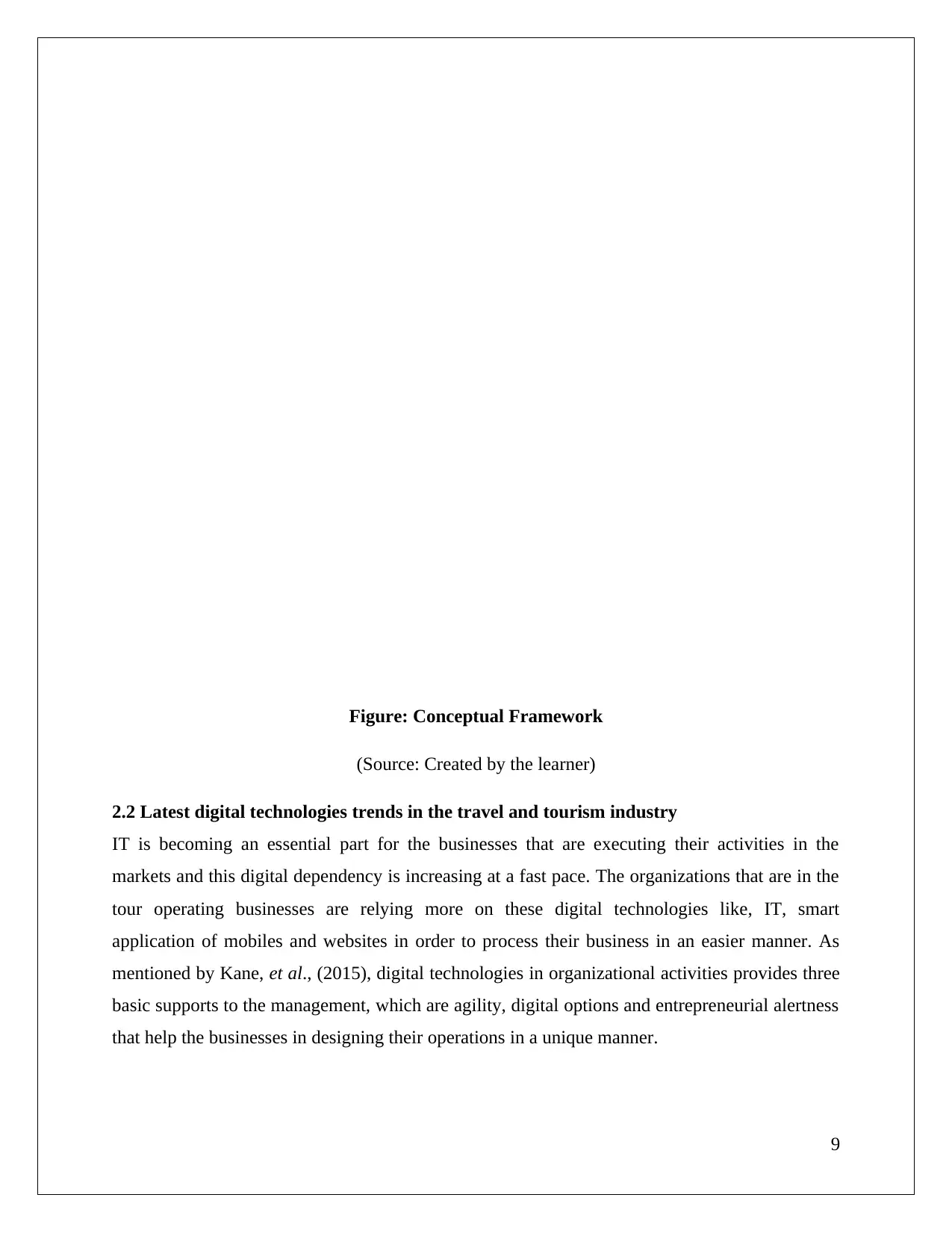
Figure: Conceptual Framework
(Source: Created by the learner)
2.2 Latest digital technologies trends in the travel and tourism industry
IT is becoming an essential part for the businesses that are executing their activities in the
markets and this digital dependency is increasing at a fast pace. The organizations that are in the
tour operating businesses are relying more on these digital technologies like, IT, smart
application of mobiles and websites in order to process their business in an easier manner. As
mentioned by Kane, et al., (2015), digital technologies in organizational activities provides three
basic supports to the management, which are agility, digital options and entrepreneurial alertness
that help the businesses in designing their operations in a unique manner.
9
(Source: Created by the learner)
2.2 Latest digital technologies trends in the travel and tourism industry
IT is becoming an essential part for the businesses that are executing their activities in the
markets and this digital dependency is increasing at a fast pace. The organizations that are in the
tour operating businesses are relying more on these digital technologies like, IT, smart
application of mobiles and websites in order to process their business in an easier manner. As
mentioned by Kane, et al., (2015), digital technologies in organizational activities provides three
basic supports to the management, which are agility, digital options and entrepreneurial alertness
that help the businesses in designing their operations in a unique manner.
9
⊘ This is a preview!⊘
Do you want full access?
Subscribe today to unlock all pages.

Trusted by 1+ million students worldwide

The websites of the businesses are developing; they are adding additional features like booking
of rooms from online platforms, feedback regarding the services they have received from the
organization and reaching out to a large audience base. Organizations that are in the UK market
are shifting their business operation from traditional to digital because of the advancement in
technologies and this is creating positive impacts on the customers of the business. Use of
websites and presence on online platforms in tour operating businesses are becoming mandatory
to attract larger customers and hence, the businesses are implementing these technologies in their
workplace to ensure better business performance. Mobile is becoming another trend of digital
technological implementation, which is creating a huge impact on the businesses and even
among the customers of the business (Mitel, 2018). Payment option is another sensitive area that
the businesses need to look after in order to ensure better presence among the targeted customers.
It is essential for the business to develop secured online payment options, which will aid the
businesses in gaining better customer attention.
2.3 Impact of digital technologies in the business operations of tour operators
Management of customers and tracking their records was a major issue that tour operators used
to face in the past, which is now being mitigated with the use of various digital technologies like
IT (Hoffman and Offutt, 2015). Storing data and making accurate financial reports are essential
for the organization to understand their position in the market (Shivaji, 2018). This is being
solved with the implementation of digital technologies and various software. Impacts of digital
implementations are both positive and negative on the tour operators. For example, Thomas
Group has a user-friendly website wherein they are able to communicate with their customers.
Hence, the feedbacks received through this portal helps the company to take decisions suiting the
customers and market needs. A government department, like VisitBritain is having attractive and
transparent digital presence, which helps the organization in creating better impact in the market
and among the targeted customers of the business. PSM and GSM are other implementations that
are made by the Disney Park and Resorts in order to make the customers understand the facilities
that the organizations are providing to their customers, which help the organization in making
better digital presence and this digital strategy has helped the organization in engaging better
customers.
10
of rooms from online platforms, feedback regarding the services they have received from the
organization and reaching out to a large audience base. Organizations that are in the UK market
are shifting their business operation from traditional to digital because of the advancement in
technologies and this is creating positive impacts on the customers of the business. Use of
websites and presence on online platforms in tour operating businesses are becoming mandatory
to attract larger customers and hence, the businesses are implementing these technologies in their
workplace to ensure better business performance. Mobile is becoming another trend of digital
technological implementation, which is creating a huge impact on the businesses and even
among the customers of the business (Mitel, 2018). Payment option is another sensitive area that
the businesses need to look after in order to ensure better presence among the targeted customers.
It is essential for the business to develop secured online payment options, which will aid the
businesses in gaining better customer attention.
2.3 Impact of digital technologies in the business operations of tour operators
Management of customers and tracking their records was a major issue that tour operators used
to face in the past, which is now being mitigated with the use of various digital technologies like
IT (Hoffman and Offutt, 2015). Storing data and making accurate financial reports are essential
for the organization to understand their position in the market (Shivaji, 2018). This is being
solved with the implementation of digital technologies and various software. Impacts of digital
implementations are both positive and negative on the tour operators. For example, Thomas
Group has a user-friendly website wherein they are able to communicate with their customers.
Hence, the feedbacks received through this portal helps the company to take decisions suiting the
customers and market needs. A government department, like VisitBritain is having attractive and
transparent digital presence, which helps the organization in creating better impact in the market
and among the targeted customers of the business. PSM and GSM are other implementations that
are made by the Disney Park and Resorts in order to make the customers understand the facilities
that the organizations are providing to their customers, which help the organization in making
better digital presence and this digital strategy has helped the organization in engaging better
customers.
10
Paraphrase This Document
Need a fresh take? Get an instant paraphrase of this document with our AI Paraphraser
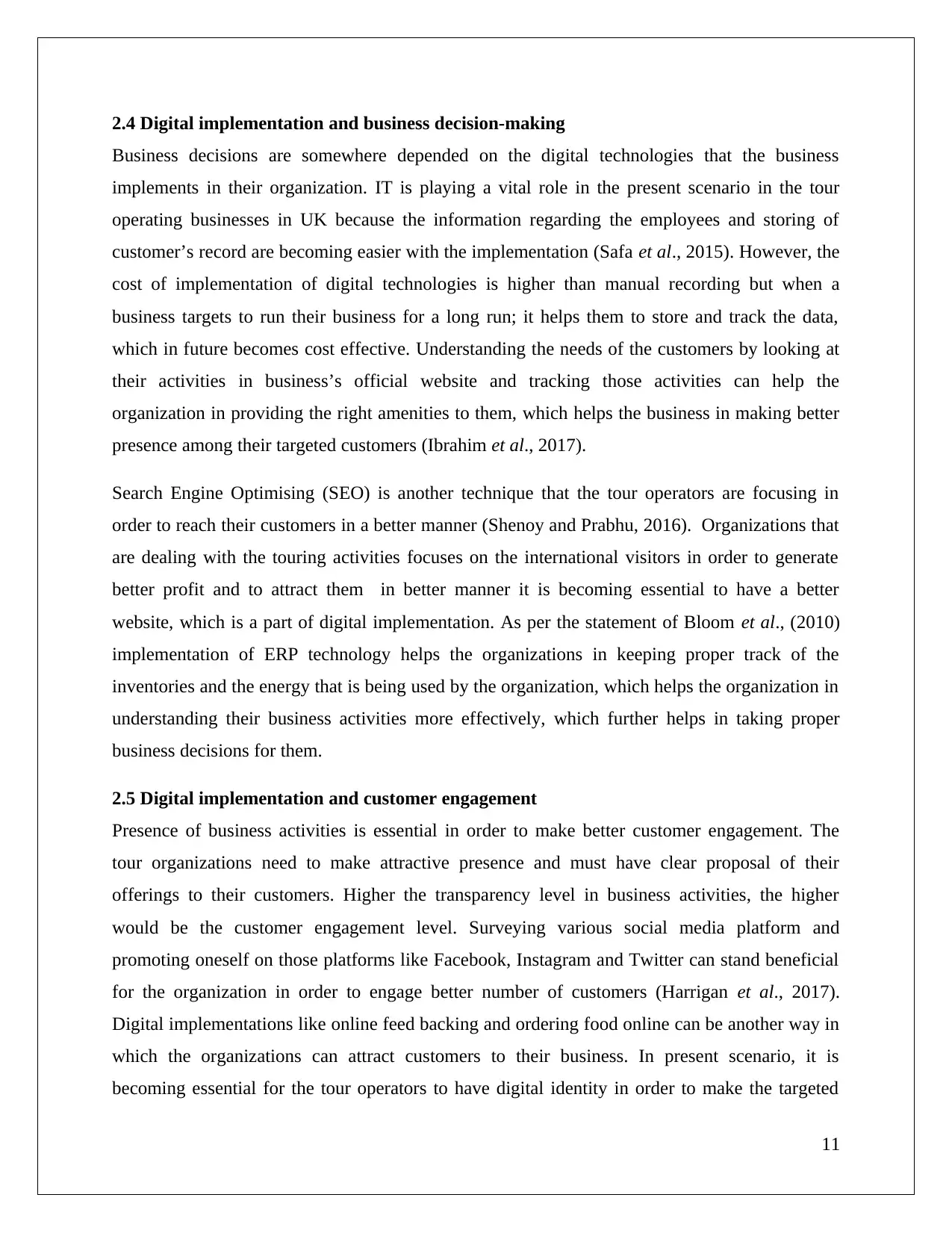
2.4 Digital implementation and business decision-making
Business decisions are somewhere depended on the digital technologies that the business
implements in their organization. IT is playing a vital role in the present scenario in the tour
operating businesses in UK because the information regarding the employees and storing of
customer’s record are becoming easier with the implementation (Safa et al., 2015). However, the
cost of implementation of digital technologies is higher than manual recording but when a
business targets to run their business for a long run; it helps them to store and track the data,
which in future becomes cost effective. Understanding the needs of the customers by looking at
their activities in business’s official website and tracking those activities can help the
organization in providing the right amenities to them, which helps the business in making better
presence among their targeted customers (Ibrahim et al., 2017).
Search Engine Optimising (SEO) is another technique that the tour operators are focusing in
order to reach their customers in a better manner (Shenoy and Prabhu, 2016). Organizations that
are dealing with the touring activities focuses on the international visitors in order to generate
better profit and to attract them in better manner it is becoming essential to have a better
website, which is a part of digital implementation. As per the statement of Bloom et al., (2010)
implementation of ERP technology helps the organizations in keeping proper track of the
inventories and the energy that is being used by the organization, which helps the organization in
understanding their business activities more effectively, which further helps in taking proper
business decisions for them.
2.5 Digital implementation and customer engagement
Presence of business activities is essential in order to make better customer engagement. The
tour organizations need to make attractive presence and must have clear proposal of their
offerings to their customers. Higher the transparency level in business activities, the higher
would be the customer engagement level. Surveying various social media platform and
promoting oneself on those platforms like Facebook, Instagram and Twitter can stand beneficial
for the organization in order to engage better number of customers (Harrigan et al., 2017).
Digital implementations like online feed backing and ordering food online can be another way in
which the organizations can attract customers to their business. In present scenario, it is
becoming essential for the tour operators to have digital identity in order to make the targeted
11
Business decisions are somewhere depended on the digital technologies that the business
implements in their organization. IT is playing a vital role in the present scenario in the tour
operating businesses in UK because the information regarding the employees and storing of
customer’s record are becoming easier with the implementation (Safa et al., 2015). However, the
cost of implementation of digital technologies is higher than manual recording but when a
business targets to run their business for a long run; it helps them to store and track the data,
which in future becomes cost effective. Understanding the needs of the customers by looking at
their activities in business’s official website and tracking those activities can help the
organization in providing the right amenities to them, which helps the business in making better
presence among their targeted customers (Ibrahim et al., 2017).
Search Engine Optimising (SEO) is another technique that the tour operators are focusing in
order to reach their customers in a better manner (Shenoy and Prabhu, 2016). Organizations that
are dealing with the touring activities focuses on the international visitors in order to generate
better profit and to attract them in better manner it is becoming essential to have a better
website, which is a part of digital implementation. As per the statement of Bloom et al., (2010)
implementation of ERP technology helps the organizations in keeping proper track of the
inventories and the energy that is being used by the organization, which helps the organization in
understanding their business activities more effectively, which further helps in taking proper
business decisions for them.
2.5 Digital implementation and customer engagement
Presence of business activities is essential in order to make better customer engagement. The
tour organizations need to make attractive presence and must have clear proposal of their
offerings to their customers. Higher the transparency level in business activities, the higher
would be the customer engagement level. Surveying various social media platform and
promoting oneself on those platforms like Facebook, Instagram and Twitter can stand beneficial
for the organization in order to engage better number of customers (Harrigan et al., 2017).
Digital implementations like online feed backing and ordering food online can be another way in
which the organizations can attract customers to their business. In present scenario, it is
becoming essential for the tour operators to have digital identity in order to make the targeted
11

customers know about their business activities, and continuous promotion though popup
advertisement and mobile application advertisement; organizations can influence the customers
to visit their organizations and to avail services from them (Ahmad et al., 2015).
Knowing preference of customers is another essential factor that the organization can understand
from their digital presence. As mentioned by Law et al., (2015), various package options and
discounts in their tariff can be other strategies that can be used by the organizations to make
better customer attraction. Showing less tariff rates in the websites and mobile application but
incurring underline profits from the shows tariff rates is another way, which is being used by
most of the organizations in present scenario.
2.7 Conclusion
The literature review concludes that digital implementations are becoming necessary for the tour
operating organizations in making better presence in the market and among its customers.
Decision-making is becoming easier for the business by making easy tracking of the customers
movement in the organization. Even the pricing of their offerings are even being aided with the
digital implementations.
12
advertisement and mobile application advertisement; organizations can influence the customers
to visit their organizations and to avail services from them (Ahmad et al., 2015).
Knowing preference of customers is another essential factor that the organization can understand
from their digital presence. As mentioned by Law et al., (2015), various package options and
discounts in their tariff can be other strategies that can be used by the organizations to make
better customer attraction. Showing less tariff rates in the websites and mobile application but
incurring underline profits from the shows tariff rates is another way, which is being used by
most of the organizations in present scenario.
2.7 Conclusion
The literature review concludes that digital implementations are becoming necessary for the tour
operating organizations in making better presence in the market and among its customers.
Decision-making is becoming easier for the business by making easy tracking of the customers
movement in the organization. Even the pricing of their offerings are even being aided with the
digital implementations.
12
⊘ This is a preview!⊘
Do you want full access?
Subscribe today to unlock all pages.

Trusted by 1+ million students worldwide
1 out of 33
Related Documents
Your All-in-One AI-Powered Toolkit for Academic Success.
+13062052269
info@desklib.com
Available 24*7 on WhatsApp / Email
![[object Object]](/_next/static/media/star-bottom.7253800d.svg)
Unlock your academic potential
Copyright © 2020–2025 A2Z Services. All Rights Reserved. Developed and managed by ZUCOL.





